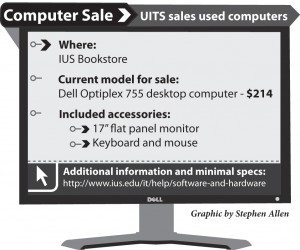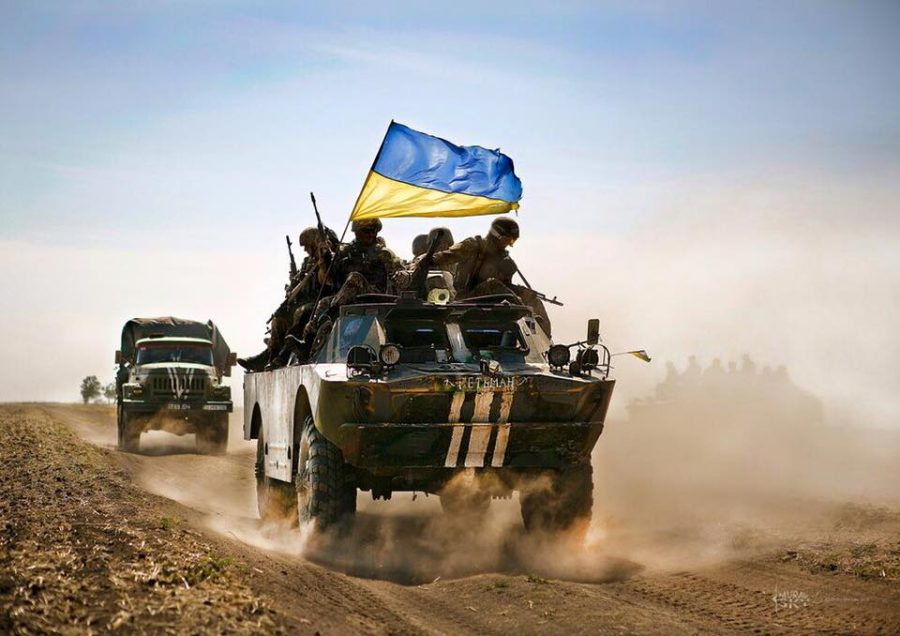 The University Information Technology Services at IU Southeast are currently selling the remaining stock of used computers at the IUS Bookstore.
The University Information Technology Services at IU Southeast are currently selling the remaining stock of used computers at the IUS Bookstore.
The ongoing sale began July 6, and, as of Sept. 26, the bookstore has about 127 remaining computers for $129 per unit.
Tom Sawyer, chief information officer, said the used computer sale results from a continual replacement of about 1,200 total campus computers during the current three-year replacement program.
“We’re going to have somewhere from 350 to 400 range of computers every summer, and we start through the process, and the sale actually goes until all of those computers are sold,” Sawyer said.
At IU Southeast, UITS initially had about 380 total computers for sale this summer. They recently reduced the price from $214 to $129.
“Since the price cut, we’re selling about 110 machines a week,” Sawyer said. “I don’t expect this to last until the end of the month.”
As of Sept. 26, Julie Faulds, manager of the IUS Bookstore, reported a sale of 148 computers.
Computer technicians refurbish the used computers, and each computer is wiped of data, physically cleaned and tested.
“When you get the keyboard or the monitor, it pretty much looks brand new as much as they can for a 3-year-old machine,” Sawyer said.
UITS sells the computers through an agreement with the IUS Bookstore.
For each used computer sold, the IUS Bookstore receives a flat-rate stipend of $25. However, the estimated expense for each computer transaction is unknown.
“If we decide to drop the price, we are not passing the cost or making a cost cut to them,” Danny Clements, user support supervisor, said. “It’s just a flat $25 fee no matter.”
The bookstore processes the purchases and credit card transactions and handles the exchange of computers.
Faulds said the transaction is very extensive and takes about two-to-three times longer than a usual textbook transaction.
However, Sawyer said this payment arrangement benefits both UITS and the IUS Bookstore.
“It’s actually a good deal for us and a good deal for them because we would have to gear up, and there are all types of hoops to jump through to certify to do that,” Sawyer said. “We don’t want to do that. It would not be cost effective for us to do that.”
UITS receives a little less than $100 per unit and transfers the revenue back into the student technology funds.
“Some campuses are not doing what we’re doing,” Sawyer said. “They turn them into university salvage and then disperse them however they want.”
The sale nets about $35,000 to $40,000 each year.
Although UITS hires full-time and part-time employees to refurbish the computers, they do not deduct money from the net profit.
“[The student technology fund] is what funds all the labs to begin with,” Sawyer said. “At the end of three years, we take whatever money we make and bring it into that fund, and we have that much more to do with the student technology fee.”
However, Sawyer said UITS is not obliged to return any profits from the sale.
“It gives us more freedom to do more things for the students with that money,” Sawyer said.
Sawyer said UITS is also considering a four-year replacement cycle for the entire Indiana University system to be implemented in 2012.
“We are probably going to a four-year cycle this next year only because computers are starting to last longer,” Sawyer said.
However, Sawyer said several tentative and unapproved changes may potentially stem from a four-year life cycle.
“We’re just looking at it now,” Sawyer said. “It’s an option. Most other campuses have gone to a four-year life cycle, and when they do, they take these funds and offer another option.”
These alternatives include the choice of a desktop or laptop for faculty and staff.
“Now, we are also looking at in the near future at several different types of workstations, [and] more all-in-one workstations for certain areas of the campus, which we haven’t done,” Sawyer said.
The all-in-one computers are enclosed within the monitor casing. The university maintains several agreements with Dell, Toshiba, Novell and Apple.
“IU is one of very few universities in the country where the IT has their computers on a life cycle replacement program at all,” Sawyer said. “IU did a very smart thing when they implemented this life cycle. Most universities would kill to be where IU is at right now.”
Students may also encounter a different workstation structure, including additional plug outlets.
“All they really want is power, and a lot of places don’t have the power that students need,” Sawyer said.
However, Clements said students are not likely to see a decrease in available computers on campus.
“The only way you would see a decrease, in my opinion, would be limited in space,” Clements said. “We work really hard to go up.”
Although the entire IU system adheres to the same program, Sawyer said IU Southeast may see a difference in the space allocated for computers in contrast to the other IU campuses.
“Not everyone has had the space that Southeast has had to allocate to student computing,” Sawyer said. “IU Southeast made a concentrated effort to dedicate spaces for student computer labs, and I think from that regard, they had some spaces and dedicated them to that. They are very sacred.”
By STEPHEN ALLEN
Staff
allen68@imail.iu.edu






